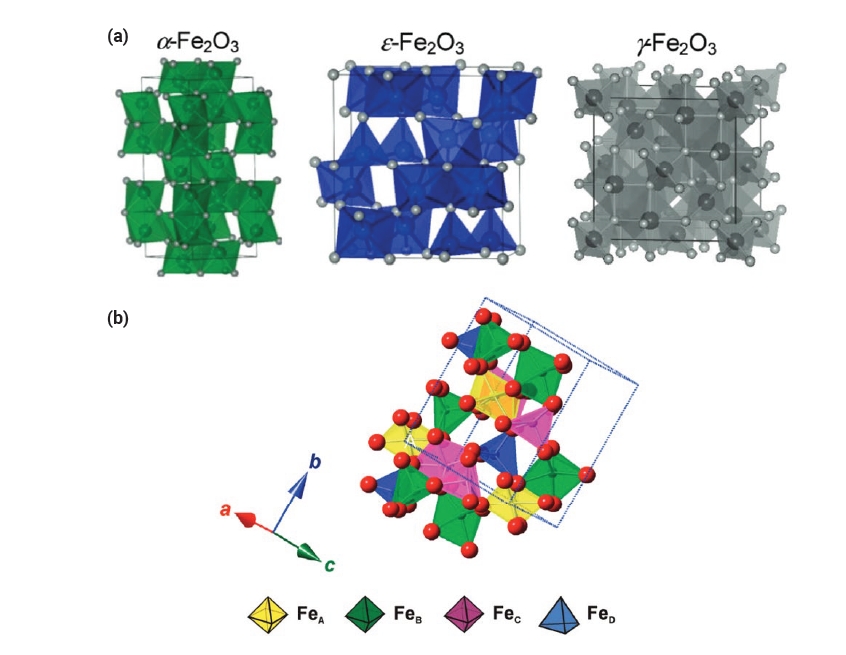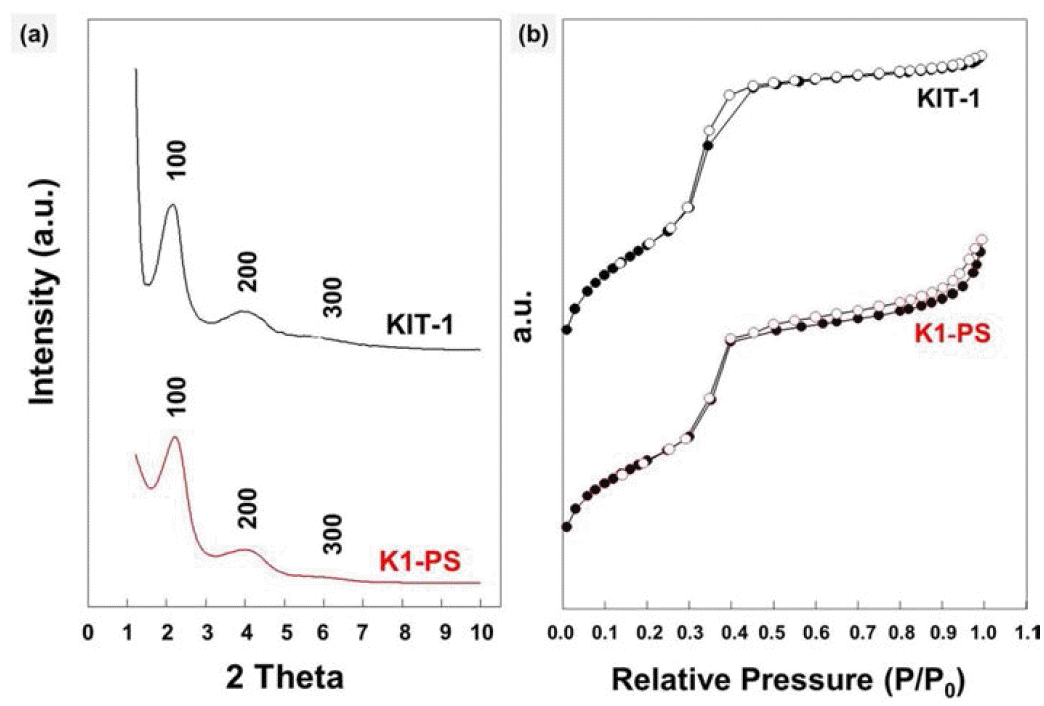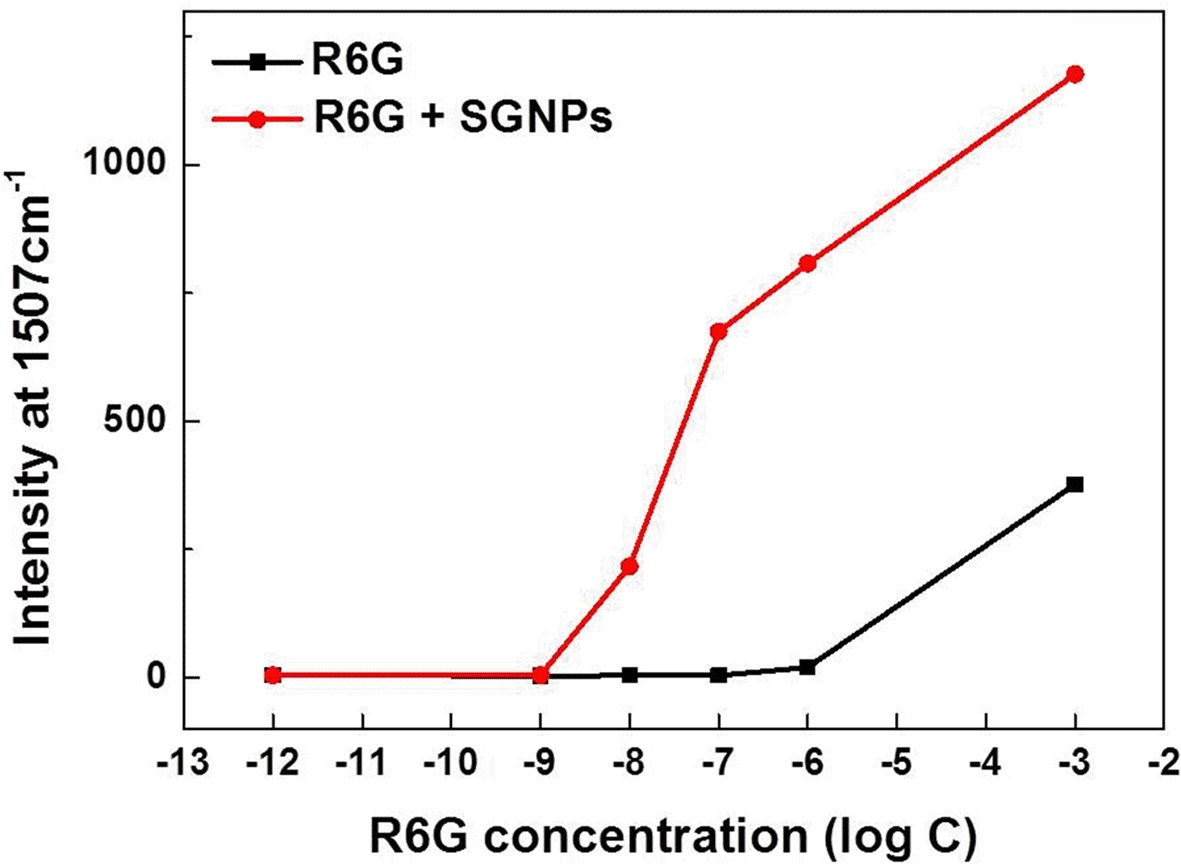- [English]
- Epsilon Iron Oxide (ε-Fe2O3) as an Electromagnetic Functional Material: Properties, Synthesis, and Applications
-
Ji Hyeong Jeong, Hwan Hee Kim, Jung-Goo Lee, Youn-Kyoung Baek
-
J Powder Mater. 2024;31(6):465-479. Published online December 31, 2024
-
DOI: https://doi.org/10.4150/jpm.2024.00290
-
-
 Abstract Abstract
 PDF PDF
- Iron oxide (ε-Fe₂O₃) is emerging as a promising electromagnetic material due to its unique magnetic and electronic properties. This review focuses on the intrinsic properties of ε-Fe₂O₃, particularly its high coercivity, comparable to that of rare-earth magnets, which is attributed to its significant magnetic anisotropy. These properties render it highly suitable for applications in millimeter wave absorption and high-density magnetic storage media. Furthermore, its semiconducting behavior offers potential applications in photocatalytic hydrogen production. The review also explores various synthesis methods for fabricating ε-Fe₂O₃ as nanoparticles or thin films, emphasizing the optimization of purity and stability. By exploring and harnessing the properties of ε-Fe₂O₃, this study aims to contribute to the advancement of next-generation electromagnetic materials with potential applications in 6G wireless telecommunications, spintronics, high-density data storage, and energy technologies.
- [Korean]
- Research trend in Fabrication of Metastable-phase Iron Nitrides for Hard Magnetic Applications
-
Kyung Min Kim, Jung-Goo Lee, Kyung Tae Kim, Youn-Kyoung Baek
-
J Korean Powder Metall Inst. 2019;26(2):146-155. Published online April 1, 2019
-
DOI: https://doi.org/10.4150/KPMI.2019.26.2.146
-
-
1,270
View
-
22
Download
-
1
Citations
-
 Abstract Abstract
 PDF PDF
Rare earth magnets are the strongest type of permanent magnets and are integral to the high tech industry, particularly in clean energies, such as electric vehicle motors and wind turbine generators. However, the cost of rare earth materials and the imbalance in supply and demand still remain big problems to solve for permanent magnet related industries. Thus, a magnet with abundant elements and moderate magnetic performance is required to replace rare-earth magnets. Recently, a”-Fe16N2 has attracted considerable attention as a promising candidate for next-generation non-rare-earth permanent magnets due to its gigantic magnetization (3.23 T). Also, metastable a”-Fe16N2 exhibits high tetragonality (c/a = 1.1) by interstitial introduction of N atoms, leading to a high magnetocrystalline anisotropy constant (K1 = 1.0MJ/m3). In addition, Fe has a large amount of reserves on the Earth compared to other magnetic materials, leading to low cost of raw materials and manufacturing for industrial production. In this paper, we review the synthetic methods of metastable a”-Fe16N2 with film, powder and bulk form and discuss the approaches to enhance magnetocrystalline anisotropy of a”-Fe16N2. Future research prospects are also offered with patent trends observed thus far. -
Citations
Citations to this article as recorded by  - Failure Cases according to Photocuring-Based Alumina 3D Printing
So-Young Ko, Shin-Il Go, Kyoung-Jun Jang, Sang-Jin Lee
Korean Journal of Materials Research.2024; 34(10): 457. CrossRef
- [Korean]
- Synthesis of KIT-1 Mesoporous Silicates Showing Two Different Macrosporous Strucrtues; Inverse-opal or Hollow Structures
-
Youn-Kyoung Baek, Jung-Goo Lee, Young Kuk Kim
-
J Korean Powder Metall Inst. 2016;23(3):189-194. Published online June 1, 2016
-
DOI: https://doi.org/10.4150/KPMI.2016.23.3.189
-
-
 Abstract Abstract
 PDF PDF
We report a facile method for preparing KIT-1 mesoporous silicates with two different macroporous structures by dual templating. As a template for macropores, polystyrene (PS) beads are assembled into uniform three dimensional arrays by ice templating, i.e., by growing ice crystals during the freezing process of the particle suspension. Then, the polymeric templates are directly introduced into the precursor-gel solution with cationic surfactants for templating the mesopores, which is followed by hydrothermal crystallization and calcination. Later, by burning out the PS beads and the surfactants, KIT-1 mesoporous silicates with macropores are produced in a powder form. The macroporous structures of the silicates can be controlled by changing the amount of EDTANa4 salt under the same templating conditions using the PS beads and inverse-opal or hollow structures can be obtained. This strategy to prepare mesoporous powders with controllable macrostructures is potentially useful for various applications especially those dealing with bulky molecules such as, catalysis, separation, drug carriers and environmental adsorbents.
- [Korean]
- Synthesis of Silica-Core Gold-Satellite Nanoparticles and Their Surface-enhanced Raman Scattering Based Sensing Application
-
Hyun Ji Choi, Young-Kuk Kim, Seok-Young Yoon, Youn-Kyoung Baek
-
J Korean Powder Metall Inst. 2014;21(6):441-446. Published online December 1, 2014
-
DOI: https://doi.org/10.4150/KPMI.2014.21.6.441
-
-
 Abstract Abstract
 PDF PDF
In this study, we synthesize silica-core gold-satellite nanoparticles (SGNPs) for the surface-enhanced Raman scattering (SERS) based sensing applications. They consist of gold satellite nanoparticles (AuNPs) fixed on the silica core nanoparticles, which sizes of AuNPs can be tunned by varying the amount of reactants (growth solution and reducing agent). Their surface plasmon resonance (SPR) properties were characterized by using UV-vis spectroscopy, showing that the growth of AuNPs on silica cores leads to the light absorption in the longer wavelength region. Furthermore, the size increase of AuNPs exhibited the dramatic change in SERS activity due to the formation of hot spots. The optimized SGNPs showing enhancement factor~3.8×106 exhibited a detection limit of rhodamine 6G (R6G) as low as 10−8 M. These findings suggest the importance of size control of SGNPs and their SPR properties to develop highly efficient SERS sensors.
- [Korean]
- Synthesis of Highly Dispersible Metal Nanoparticles in P3HT:PCBM Layers and Their Effects on the Performance of Polymer Solar Cells
-
Min-Ji Kim, Gyu-Chae Choi, Young-Kuk Kim, Yang-Do Kim, Youn-Kyoung Baek
-
J Korean Powder Metall Inst. 2014;21(3):179-184. Published online June 1, 2014
-
DOI: https://doi.org/10.4150/KPMI.2014.21.3.179
-
-
 Abstract Abstract
 PDF PDF
In this study, we prepare polymer solar cells incorporating organic ligand-modified Ag nanoparticles (OAgNPs) highly dispersed in the P3HT:PCBM layer. Ag nanoparticles decorated with water-dispersible ligands (WAgNPs) were also utilized as a control sample. The existence of the ligands on the Ag surface was confirmed by FTIR spectra. Metal nanoparticles with different surface chemistries exhibited different dispersion tendencies. O-AgNPs were highly dispersed even at high concentrations, whereas W-AgNPs exhibited significant aggregation in the polymer layer. Both dispersion and blending concentration of the Ag nanoparticles in P3HT:PCBM matrix had critical effects on the device performance as well as light absorption. The significant changes in short-circuit current density (JSC) of the solar cells seemed to be related to the change in the polymer morphology according to the concentration of AgNPs introduced. These findings suggested the importance of uniform dispersion of plasmonic metal nanoparticles and their blending concentration conditions in order to boost the solar cell performance.
- [Korean]
- Research Trend of Ceramic Filter for Water Treatment
-
In-Hyuck Song, Jang-Hoon Ha, Byungseo Bae, Young-Jo Park, Jae-Woong Ko, Youn-Kyoung Baek, Young-Kuk Kim, Jung-Goo Lee, Yoo-Dong Hahn
-
J Korean Powder Metall Inst. 2014;21(1):62-71. Published online February 1, 2014
-
DOI: https://doi.org/10.4150/KPMI.2014.21.1.62
-
-
2,015
View
-
19
Download
-
4
Citations
-
 PDF PDF
-
Citations
Citations to this article as recorded by  - Reactive ceramic pellets incorporated iron for removing As(III), As(V), and Cr(VI) from aqueous solutions
Sunwon Rha, Yun Sik Gong, Ho Young Jo
Desalination and Water Treatment.2019; 158: 174. CrossRef - Application of Physical and Chemical Enhanced Backwashing to Reduce Membrane Fouling in the Water Treatment Process Using Ceramic Membranes
Seogyeong Park, Joon-Seok Kang, Jeong Jun Lee, Thi-Kim-Quyen Vo, Han-Seung Kim
Membranes.2018; 8(4): 110. CrossRef - Effects of particle size and forming pressure on pore properties of Fe-Cr-Al porous metal by pressureless sintering
Bon-Uk Koo, Yujeong Yi, Minjeong Lee, Byoung-Kee Kim
Metals and Materials International.2017; 23(2): 336. CrossRef - Characterization and Microstructure of an Extruded Flat-Tubular-Type Alumina Filter
Byung-Seo Bae, Jang-Hoon Ha, In-Hyuck Song
Journal of the Korean Ceramic Society.2014; 51(5): 406. CrossRef
|











